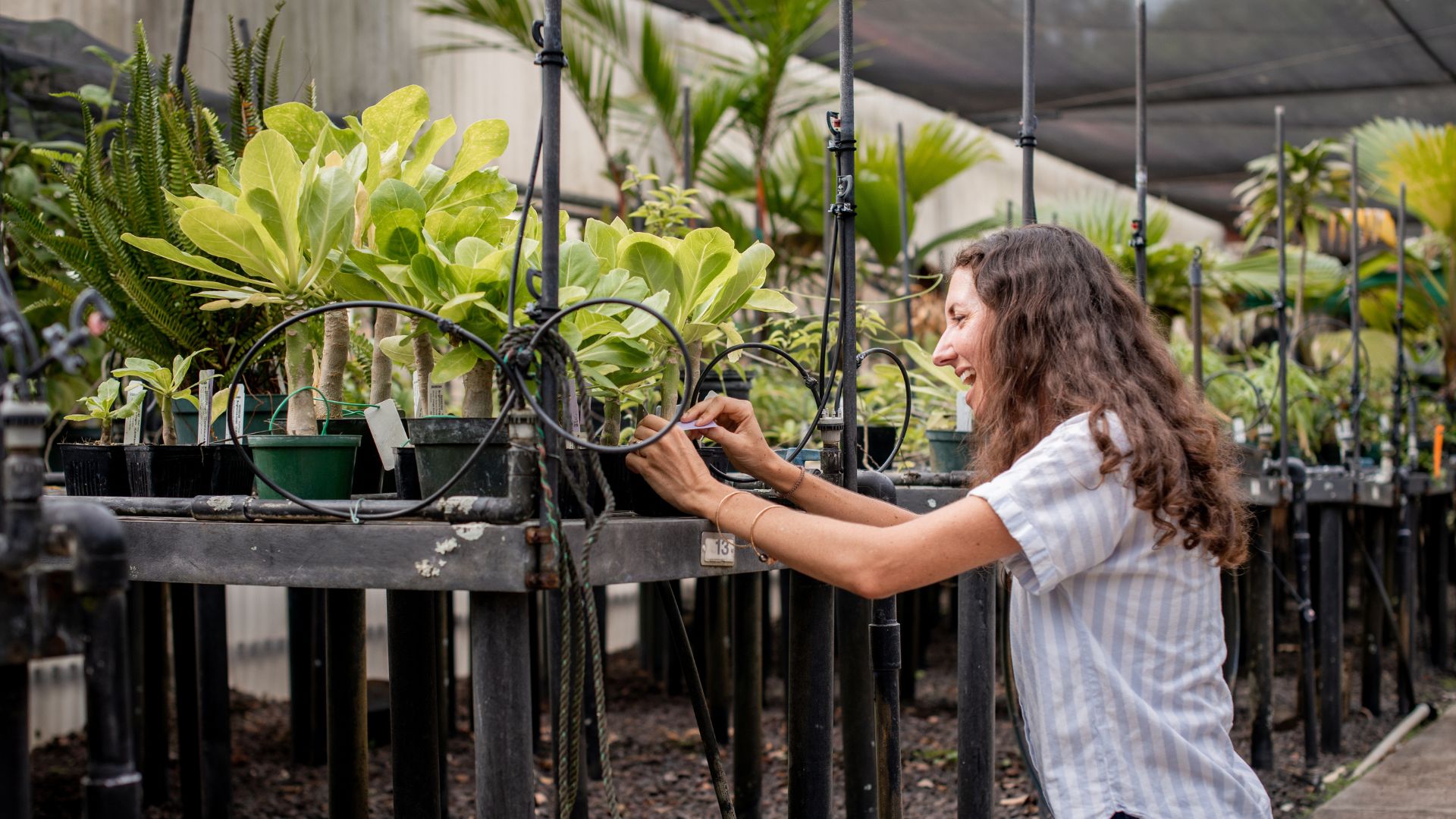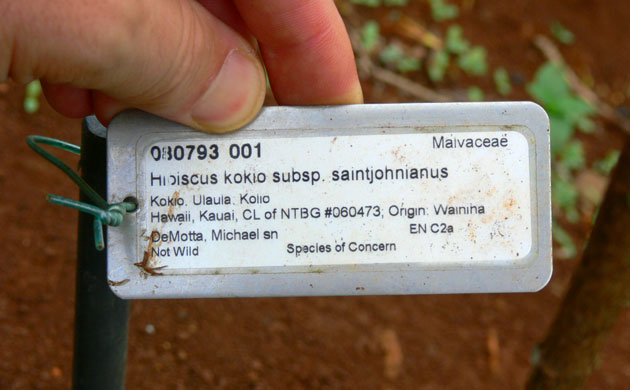Each plant collection can be traced back to its origin, where and when it was originally collected in the wild, or if it was received through exchange with another botanical garden. Each plant collection is accompanied by a unique identification number, as well as herbarium collection also called a voucher specimen, and a plant record entry that contains any other accompanying information, such as a description of the habit and habitat it was found in and any known local names, uses or other important features. National Tropical Botanical Garden (NTBG) collaborates with many other botanical gardens and arboreta through American Public Gardens Association (APGA) and Botanical Garden Conservation International (BGCI). NTBG holds the highest levels of accreditations as both Accredited Arboretum (ArbNet Level IV) and as Advanced Conservation Practitioner from BGCI.

To ensure the health and well-being of our living collections, NTBG’s Living Collections and Horticulture Program develops horticultural practices to care for the collections, propagates at-risk plant species, and ensure that the living collections in the gardens have proper curation and interpretation.
The initial step in the process is to determine which plants are to be included in the collections. Guidelines established based on research, conservation, and education initiatives consider any adverse consequences that could result from the introduction of species from other regions. Plant records are maintained that document the origins and status of plant material in the collections. This and other policies pertaining to management of NTBG’s living and non-living (herbarium, library) collections are outlined in the Collections Policy.
The categories of collections in NTBG’s gardens are diverse, requiring a wide range of expertise. For example, many native Hawaiian species had never before been cultivated, making it necessary for horticultural staff to pioneer new propagation protocols. The staff has access to a wide range of facilities, including the state-of-the-art nursery facilities in McBryde Garden and smaller greenhouses in the other gardens; a micropropagation laboratory where in vitro trials are being conducted; and a seed bank, which serves as a repository for genetic resources. All techniques are considered when determining how to give the most at-risk plants their last and best chance for survival.
Horticultural staff is developing a number of techniques to protect the plants and enhance the likelihood of survival. An integrated pest management program is employed that uses ecologically sound strategies to control threats to the plants from insects and diseases. Staff also continue to explore better techniques to recycle plant debris into compost for use in the gardens. Because of the fragile state of some rare species, NTBG has identified the most critical plants to be secured in hardened shelters in anticipation of severe storms. Storms and other natural adversities are inevitable. By nurturing the living collections in NTBG’s gardens we are helping to protect rare species from natural as well as human threats to their survival.

With its vast collections of living plants and their seeds, NTBG must maintain an accurate record of each of these materials for a variety of purposes. Our database of plant records includes tens of thousands of entries — every plant collected, propagated, and preserved in the gardens and ecological restoration projects. Each plant is assigned a unique number that will follow it throughout its life in the nursery and out into the gardens. This number is the accession (catalog) number. This number is entered into the database, along with the name of the species, the location from which it was collected, the name of the collector, and a wealth of other known information, including the parentage of the specimen and the conservation status for the species.This information is a snapshot in time of the environment where the collection was made creating a record that future researchers can refer to. The destination, whether it be in one of NTBG’s gardens, preserves, or another location, is added when determined.
Records like these are essential; they are part of what differentiates a botanical garden from a display garden. They include scientific data used by NTBG’s research and conservation programs, as well as an inventory of what is available in the gardens for further propagation, educational studies, and enjoyment.
A special label is prepared to identify the plant material while it is in the greenhouse, seed bank, or micropropagation laboratory. A somewhat different tag is used for plants in the ground that contains such pertinent information as the accession number, name, conservation status, and location collected. This allows staff, visiting scientists, and students to identify immediately the plants they see. Additional interpretive signage for our visitors may contain useful background information about the plant.
An important component of NTBG’s plant records system is digital maps of the gardens, showing the identity and location of each plant. Digital mapping is an important extension of our plant records and tagging activities. Such maps provide an immediate overview of the plants in a particular area of the gardens. They also are highly useful in the proper identification of a plant in the ground should a tag become damaged or lost.

Many of the rare plants growing in NTBG’s gardens and restoration sites have been produced by the organization’s sophisticated nursery operations. The climate-controlled micropropagation lab and greenhouse facilities at the Conservation and Horticulture Center in the McBryde Garden currently produce over 10,000 plants per year. Many of these are rare plants native to Hawai’i and the South Pacific region. NTBG’s other gardens also have basic greenhouse facilities, though much smaller in scale.
One way to understand how the complex operation of propagating an at-risk plant works is to follow its progress after it has been brought to the facility. The process begins for most plants in the nursery when field botanists bring in seeds or cuttings (propagules) collected from wild specimens. The materials for propagation are cataloged — all pertinent data is recorded in the computer database. A pressed plant voucher may also have been collected with this material to confirm its identity. This voucher would be placed in NTBG’s herbarium and the records cross-referenced to the collected material in the nursery. Propagules may go directly to the nursery, or the seeds may be stored in the NTBG Seed Bank.. In the nursery, fresh plant cuttings are placed on mist tables, where rooting media are kept moist while the plant material establishes roots. Seeds collected for immediate propagation are prepared by removing any pulp or outer husk. Seeds that are slow to germinate, because of a thick coat, may be scarified (scratched or nicked) and soaked for several hours or more.
When seedlings or cuttings have suitably rooted, they are ready for the next step. They are gently removed from the medium and placed in small pots filled with sterile potting medium (fine black cinders for many plants). At this stage the plants are growing in the shelter of the greenhouse, under carefully climate-controlled conditions; they are automatically watered daily and moderately shaded. As they grow into larger pots, the plants are gradually hardened by moving them to the adjacent shadehouse, where they get more sun but not full exposure. Once they are approaching an appropriate size for outplanting, the young plants are put out in the “sunny nursery” where they get essentially full sun and less water. Once they are fully acclimatized, they are ready to go into the ground, most likely in one of NTBG’s gardens or restoration sites.

Plants adapted to high, cold areas of the islands are treated somewhat differently as they proceed through the facility. After rooting, many of these often-rare plants are moved to the cool room. From there, cold-adapted native species may be outplanted into one of our gardens or restoration sites. The time it takes for a plant to move through the entire facility, from seed or cutting to outplanting, varies from a few months to a few years. By producing large quantities of a diverse assortment of plants, NTBG is best able to propagate species for its conservation, research, and education programs and also to provide plants for community outreach efforts, educational institutions, and collaborating landowners.
As a responsible member of the botanical garden, scientific, conservation, and education communities, National Tropical Botanical Garden adopts and practices principles or codes of conduct either individually as an institution or in collaboration with other organizations, agencies, and individuals.
On February 27, 2007 the National Tropical Botanical Garden endorsed the Principles on Access to Genetic Resources and Benefit Sharing, which had been developed by a number of botanic gardens and herbaria worldwide. In accordance with these principles, NTBG developed and adopted the:
Invasive species represent a significant threat to the native flora of tropical regions. NTBG has further formalized its commitment by joining with other non-governmental institutions, government agencies, associations, and members of the private sector to prevent the use and distribution of invasive plant species by adopting voluntary codes of conduct.
National Tropical Botanical Garden Voluntary Codes of Conduct for Botanical Gardens and Arboreta (PDF)
National Tropical Botanical Garden Voluntary Codes of Conduct for Green Industry – Kaua’i specific (PDF)
See also: NTBG Living Collections Policy
A group of 44 people from ethnobotany and associated disciplines participated in an Ethnobotany Summit at NTBG Headquarters in January 2007. Considering the grave environmental crisis facing the world today, the loss of biodiversity and the loss of culture, the group issued a statement to stress the importance of ethnobotany for providing some of the solutions towards more sustainable living.
The Kaua’i Declaration (PDF)
To learn more about our collections browse these pages. Some of our underlying databases are public. Access to the herbarium and library collections in the Juliet Rice Wichman Botanical Research Center for scientific or education purposes can be arranged. See contact information under each collection.
Public tours of NTBGs five gardens can be booked online. The Behind the Scenes tour, South Shore Kauai includes the nursery and botanical research center.